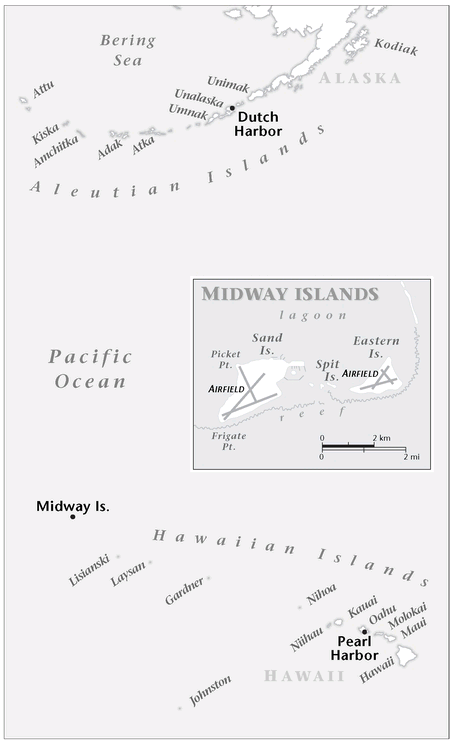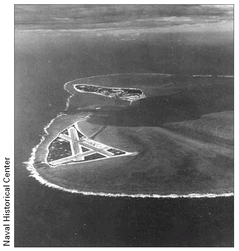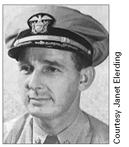War Stories II (22 page)
Authors: Oliver L. North
 STATION HYPO
STATION HYPOPAC FLEET SIGNALS INTELLIGENCE CENTER
OAHU, HAWAII
20 MAY 1942
OAHU, HAWAII
20 MAY 1942
As Admiral Fletcher limped back toward Hawaii with the damaged
Yorktown
and her escorts, he couldn't tell who had won the Battle of the Coral Sea. He didn't know until he arrived back in Pearl Harbor that in Rabaul, Admiral Inouye, having lost the element of surprise, had already recalled the Port Moresby invasion force for fear that the transports might still be engaged by a surface force or attacked by land-based aircraft.
Yorktown
and her escorts, he couldn't tell who had won the Battle of the Coral Sea. He didn't know until he arrived back in Pearl Harbor that in Rabaul, Admiral Inouye, having lost the element of surprise, had already recalled the Port Moresby invasion force for fear that the transports might still be engaged by a surface force or attacked by land-based aircraft.
The consequences of the fight were clearer to those who had monitored the battle from Hawaii. Tactically, Nimitz judged the outcome to be a modest Japanese victory. Though the Japanese had lost far more aircraft and suffered many more casualties, the loss of the 30,000-ton
Lexington
was far
more serious than the sinking of the 12,000-ton
Shoho
. And the small Japanese destroyer-transport and barges sunk at Tulagi hardly equaled the loss of the
Neosho
and the
Sims,
as far as the U.S. Navy was concerned.
Lexington
was far
more serious than the sinking of the 12,000-ton
Shoho
. And the small Japanese destroyer-transport and barges sunk at Tulagi hardly equaled the loss of the
Neosho
and the
Sims,
as far as the U.S. Navy was concerned.
But from a strategic perspective, Nimitz considered this first engagement, in which the opposing ships never saw each other, as a victory for the Americans. For the first time since the war began, the Japanese had been forced to turn back an invasion force. He and his commanders had validated the use of Station Hypo intercepts in “near-real” timeâmeaning that the intelligence was useful in the midst of a battle, not just in planning one.
Now, on 9 May, as dawn was breaking in Hawaii, Nimitz had even bigger concerns. On 5 May, just before the battle was joined in the Coral Sea, Station Hypo had intercepted a message from Imperial Fleet headquarters in Kure to the Combined Fleet. The message, now almost totally decrypted by Rochefort's code-breakers, ordered the invasion of a place designated as “AF” to commence on 4 June.
Nimitz was now down to two undamaged carriers. He had only the
Enterprise
and the
Hornet
, which had not yet engaged in anything except the Doolittle Raid. Now he needed them to stop a major Japanese invasion of a place called AF. And as of 9 May, he didn't even know where AF was. He decided to press Rochefort and Layton a little bit harder to come up with the answer before it was too late.
Enterprise
and the
Hornet
, which had not yet engaged in anything except the Doolittle Raid. Now he needed them to stop a major Japanese invasion of a place called AF. And as of 9 May, he didn't even know where AF was. He decided to press Rochefort and Layton a little bit harder to come up with the answer before it was too late.

CHAPTER 6
TURNING POINT: THE BATTLE OF MIDWAY
(JUNE 1942)
 MIDWAY ATOLL
MIDWAY ATOLL1,137 MILES NORTHWEST OF HAWAII
10 MAY 1942
10 MAY 1942
M
idwayâ1,100 miles west-northwest of Hawaii, an atoll of two tiny islands, is just 2.4 square miles of land barely above water. The highest terrain features are radio pylons on Sand Island and the control tower at the airfield on Eastern Island. Before the war Midway had been a weather station and refueling stop for the Pan American Airways Flying Clippersâthe first trans-Pacific air service. In 1935, the U.S. Navy had worked a secret deal with Pan Am to significantly increase aviation fuel storage on Eastern Island and to have Pan Am service Navy PBYs that landed at the big seaplane ramp.
idwayâ1,100 miles west-northwest of Hawaii, an atoll of two tiny islands, is just 2.4 square miles of land barely above water. The highest terrain features are radio pylons on Sand Island and the control tower at the airfield on Eastern Island. Before the war Midway had been a weather station and refueling stop for the Pan American Airways Flying Clippersâthe first trans-Pacific air service. In 1935, the U.S. Navy had worked a secret deal with Pan Am to significantly increase aviation fuel storage on Eastern Island and to have Pan Am service Navy PBYs that landed at the big seaplane ramp.
Before 7 December 1941, Midway had been practically defenseless. But it wasn't anymore. At the very moment Fuchida's aircraft were lifting off for Pearl Harbor, the
Lexington
had been delivering planes to the Marines assigned to protect Midway. Immediately afterward, the Navy took over the island and began to beef up its defenses.
Lexington
had been delivering planes to the Marines assigned to protect Midway. Immediately afterward, the Navy took over the island and began to beef up its defenses.
By New Year's Day, 1942, and for the next five months, Midway had a strong garrison of Marines equipped with anti-aircraft and coastal defense guns, a fighter squadron, and a scout-bomber squadron. Admiral Nimitz had given Midway all the troops, guns, and aircraft the atoll could hold until the runways and aprons were expanded and more barracks built.
Yamamoto tested the island's defenses in late January, when one of his submarines surfaced and tried to take out Midway's radio station with its deck gun. A Marine three-inch battery opened up and forced the sub to make a panicked dive just minutes after it had surfaced. There were two more sub attacks on the island during the next two weeks, with the same results.
On 1 March the two Marine air squadrons were melded into a new unit, dubbed Marine Air Group 22, and brought up to a full complement of sixty-four aircraft. The new group was formed from Fighter Squadron 221, flying antiquated, Navy cast-off F2A-3s, and Marine Scout Bombing Squadron 241, with hand-me-down Navy SB2U-3 Vindicators the Marines nicknamed “Vibrators” because the ancient engines were so ragged. Unfortunately, the Marine pilots assigned to fly the SB2s were fresh out of flight school and untrained in dive-bombing. So when they arrived on Midway they began practicing shallow-glide bombing attacksâa tactic that would prove to be lethal.
Â
Airfield at Midway.

By 18 May 1942, Admiral Nimitz had done all he could with what he had available to improve Midway's defenses. For more than a week, in the aftermath of the shootout in the Coral Sea, Commanders Edwin Layton and Joseph Rochefort had been telling him that they were “fairly sure” that the entire Imperial Combined Fleet was about to invade the place.
 STATION HYPO
STATION HYPOPAC FLEET SIGNALS INTELLIGENCE CENTER
OAHU, HAWAII
20 MAY 1942
OAHU, HAWAII
20 MAY 1942
On 5 May, as the battle in the Coral Sea was developing, an Australian radio intercept siteâpart of Rochefort's “Magic” networkâpicked up and transcribed a long message in JN-25. The message was passed to Station Hypo still encrypted, but within two days, Rochefort's code-breakers determined that it was an operations plan issued by Combined Fleet headquarters in Kure ordering an invasion of two widely separated U.S. installations.
By 10 May the team at Station Hypo had determined that the lightly defended U.S. bases on Adak, Attu, and Kiska in Alaska's Aleutian Islands chain had been targeted for invasion.
A second target identified in the intercepted message was designated by the letters “AF” in the Japanese code. But the code books being so painstakingly assembled by Commanders Rochefort and Layton, Lt. Commander T. H. Dyer, and others in the Hypo bunker had no reference for “AF.” They simply did not know where it wasâand yet, according to the Combined Fleet message, AF was to be attacked a day after the Aleutians. And what an attack it was planned to be!
Â
Commander Joseph Rochefort

From the 5 May intercept and subsequent messages, the code-breakers determined that AF was to be struck by six heavy carriers, the
Akagi
,
Kaga
,
Hiryu
,
Soryu
,
Shokaku
, and
Zuikaku
, and the light carriers
Hosho
and
Zuiho
. Accompanying them were to be more than forty destroyers, fifteen submarines, seaplane tenders, and dozens of transports and support ships. After surprise air strikes to destroy U.S. aircraft on the ground, three cruisers and seven battleships would then bombard AF, including the biggest battleship in the world, the
Yamato
, Admiral Yamamoto's flagship. After this “softening up,” AF would be assaulted and occupied by a force of 5,000 troops.
Akagi
,
Kaga
,
Hiryu
,
Soryu
,
Shokaku
, and
Zuikaku
, and the light carriers
Hosho
and
Zuiho
. Accompanying them were to be more than forty destroyers, fifteen submarines, seaplane tenders, and dozens of transports and support ships. After surprise air strikes to destroy U.S. aircraft on the ground, three cruisers and seven battleships would then bombard AF, including the biggest battleship in the world, the
Yamato
, Admiral Yamamoto's flagship. After this “softening up,” AF would be assaulted and occupied by a force of 5,000 troops.
By 15 May, Nimitz had learned through other intercepts that the carrier
Shokaku
wouldn't be at AF. She was at Truk undergoing extensive repairs from the damage sustained during the Coral Sea battle. And his intelligence officer had other intelligence that the
Zuikaku
wouldn't make it to AFâwherever it wasâbecause the carrier had lost most of its air group in the same battle.
Shokaku
wouldn't be at AF. She was at Truk undergoing extensive repairs from the damage sustained during the Coral Sea battle. And his intelligence officer had other intelligence that the
Zuikaku
wouldn't make it to AFâwherever it wasâbecause the carrier had lost most of its air group in the same battle.
But to Nimitz, the lack of these two carriers hardly mattered. The Japanese force headed for AF was the biggest naval armada ever assembledâ145 shipsâand he still didn't know where they were going.
By 19 May, Layton and Rochefort were convinced that AF was Midway. But others, including many on his staff, thought it could be Darwin, Australia, mainland Alaska, or even Hawaii itself. Nimitz had to know. His only two operational carriers, the
Hornet
and the
Enterprise
, were in the South Pacific, east of Australia. The badly battered
Yorktown
had limped to Tonga near the Fiji Islands and was now headed slowly back to Pearl Harborâwith estimates that repairs from the damage sustained in the Coral Sea would take three months. Nimitz knew that if he put his carriers in the wrong place he could precipitate a disaster worse than the Day of Infamy.
Hornet
and the
Enterprise
, were in the South Pacific, east of Australia. The badly battered
Yorktown
had limped to Tonga near the Fiji Islands and was now headed slowly back to Pearl Harborâwith estimates that repairs from the damage sustained in the Coral Sea would take three months. Nimitz knew that if he put his carriers in the wrong place he could precipitate a disaster worse than the Day of Infamy.
Other books
Sleeping Beauty by Ross Macdonald
Pieces of Me by Darlene Ryan
The Journey by Josephine Cox
The Full Circle Six by Edward T. Anthony
The World According To Garp by John Irving
Gone Crazy in Alabama by Rita Williams-Garcia
I'll Be Watching You by M. William Phelps
Swansong by Christo, Rose
College Sex - Philosophy for Everyone: Philosophers With Benefits by Michael Bruce, Fritz Allhoff
Perfectly Shattered by Trent, Emily Jane